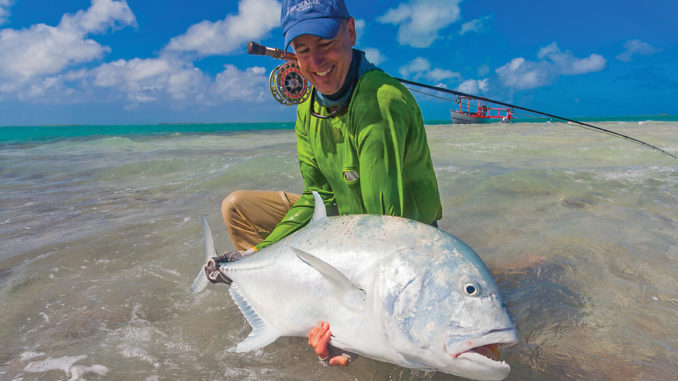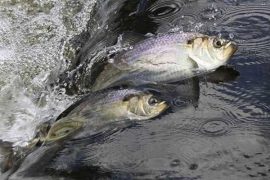
Photographs by Dylan Rose
When I first visited Kiribati, in 2011, there were three ways to pursue giant trevally: 1) post up on a flat adjacent to fast-flowing channels, and chum with chopped-up milkfish while waiting for the fish to show; 2) cruise the edges of flats in a motorized catamaran, scanning for GTs that could then be stalked on foot; 3) stalk the flats hoping to encounter a GT, perhaps slinging a 12-weight over a shoulder as you cast to bonefish with an 8-weight to pass the time.
I spent a bit of time pursuing methods 2 and 3 but must admit that I dropped them like a stonefish after one particularly effective day of chumming. On that day, as our guides tossed chunks of milkfish into the current, we fished a small coral island opposite a deep channel, scanning the turquoise water for a glimpse of fish. Our group of four anglers all hooked and landed GTs (one weighing more than 40 pounds) and lost several others.
While chumming for pelagic species—mako sharks come to mind—raises few eyebrows, the idea of chumming for shallow-water species is unsettling for many. One booking agent I know put it this way: “Part of the joy in chasing incredible gamefish like giant trevally is the challenge, and to dumb it down by chumming simply dampens the experience for everyone.”
He’s right, of course. But here’s my question: What if the fish aren’t showing up without that bloody elixir and you have only a day remaining to catch a GT in this lifetime?
In a moment of high-roadedness, I can say that the fish I landed—a modest 10-pound specimen—came before the chumming bloodbath ensued. I spotted two fish cruising by as the guides were anchoring the catamaran. I landed the fly before them and was duly rewarded.

Fast forward to 2015 when I visited Kiribati again. Since my previous visit, another lodge had opened on Christmas Island and fishing pressure had increased. Though the lagoon at…





